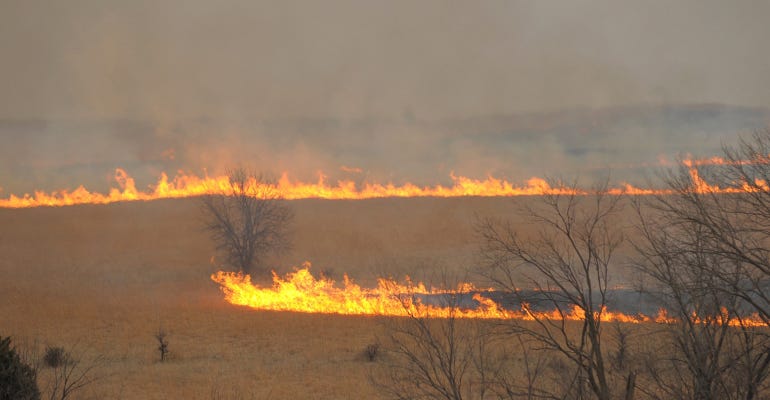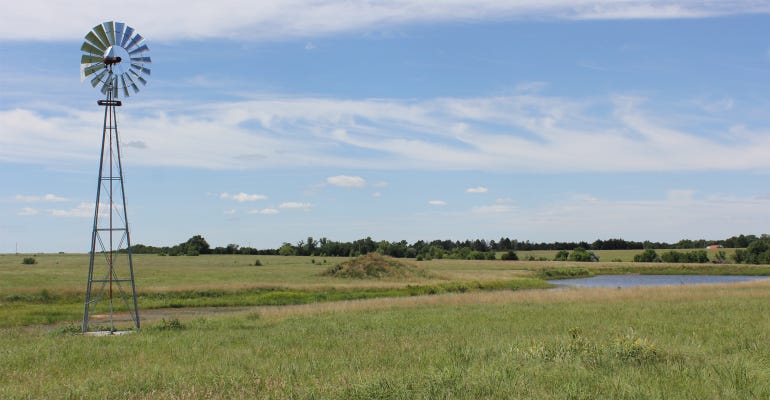
There’s no surer signs of spring in Kansas than the rapid flush of green in the newly burned pastures of the Flint Hills and the rolling of the cattle trucks bringing the burgers and beefsteaks of next year to munch on the rich, tender new grasses.
For grazers, there’s optimism this year after plentiful rains brought a good supply of the subsurface water that started springs bubbling and filled pasture ponds to the brim.
“Going into spring stocking, we’re looking really good,” says Mike Holder, Kansas State University Extension ag agent in Chase County. “We are about 70% done with spring burning as we hit mid-April. The weather has been pretty cool, so the grass has been a little slow to green back up. I think if we get a shower or two and a warmup we’ll be seeing a lot of green out there as we head into May.”
Ranchers in Chase County are “holding their own” against invasive species such as sericea lespedeza, old world bluestem and eastern red cedars, he says.
“Sericea is something that we are never going to get completely rid of, but for the most part we are keeping it from getting worse,” he says. “There are places where controlling it is just going to be a constant battle. Scouting for outbreaks of it and spraying to kill it are just a fact of life now.”
Holder adds that he hasn’t seen widespread fall burning in his area yet, but he has heard of success stories in other parts of the state where a pasture burn in late July or early August before the sericea plants can produce seed is helping to keep the invader at bay.
 POWER OF FIRE: April is the traditional month of burning for pastures. Fire removes the old, dead grass from the previous season and exposes the soil to the sun, which leads to an almost immediate new flush of green grass.
POWER OF FIRE: April is the traditional month of burning for pastures. Fire removes the old, dead grass from the previous season and exposes the soil to the sun, which leads to an almost immediate new flush of green grass.

“The stuff is tough. You can burn it in the fall, and it will sprout back up in the spring,” he says. “But stopping seed production does show some promise. I think folks just have to accept that you are going to have to do a fall burn every couple of years or you’ll start to see it coming back.”
Regular spring prescribed burning keeps red cedars at bay, Holder says, but old world bluestem continues to be hard to eradicate.
In Greenwood County, Extension agent Lindsay Shorter says pastures that had been burned early were starting to green up by mid-April. She expects more burning to be done as weather permits.
The county has had an abundance of moisture from fall through winter, and water supplies are looking good going into grazing season, she says.
On the economic front, Shorter says livestock markets and the ag economy in general are facing economic challenges made worse by the COVID-19 pandemic.
“Cattlemen are wanting to know if they would have a leg to stand on asking landowners to consider a lower rental rate this year because of the cattle market being down,” she says. “The conversation is ongoing in some situations to lower rental rates this year due to the economy and the markets. Whether that actually happens this year is yet to be seen.”
She says old world bluestem is a major threat in Greenwood County, and she has seen some producers who are more worried about it than about sericea.
 FULL PONDS: Plentiful rains from fall through winter have the ponds full and the springs bubbling across the Flint Hills. Ranchers are hoping for a good grazing season as cattle begin arriving for the typical intensive early stocking season.
FULL PONDS: Plentiful rains from fall through winter have the ponds full and the springs bubbling across the Flint Hills. Ranchers are hoping for a good grazing season as cattle begin arriving for the typical intensive early stocking season.

“The majority of producers are aware of these threats and working hard to eradicate them. Some are having luck with late summer burns if they are done correctly within the right time frame, which is late summer, not fall, and the burn is followed by a cooperating weather pattern that allows the grasses to get in good regrowth before winter sets in.”
K-State researcher K.C. Olson completed a four-year study on the impact of late summer burning on sericea lespedeza in 2019 and is planning to build on that with future studies on how best to integrate late-summer fire in cow-calf and yearling production systems.
His research showed the incidence of sericea is higher in pastures burned in April than in those burned in August and September.
Olson says researchers chose to concentrate research on off-season fires because they thought it would be compatible with intensive early stocking as is practiced in the Flint Hills. He says that after just one year of burning, sericea lespedeza failed to make seed. After the third year of burning, the number of plants in the field fell dramatically.
About the Author(s)
You May Also Like






